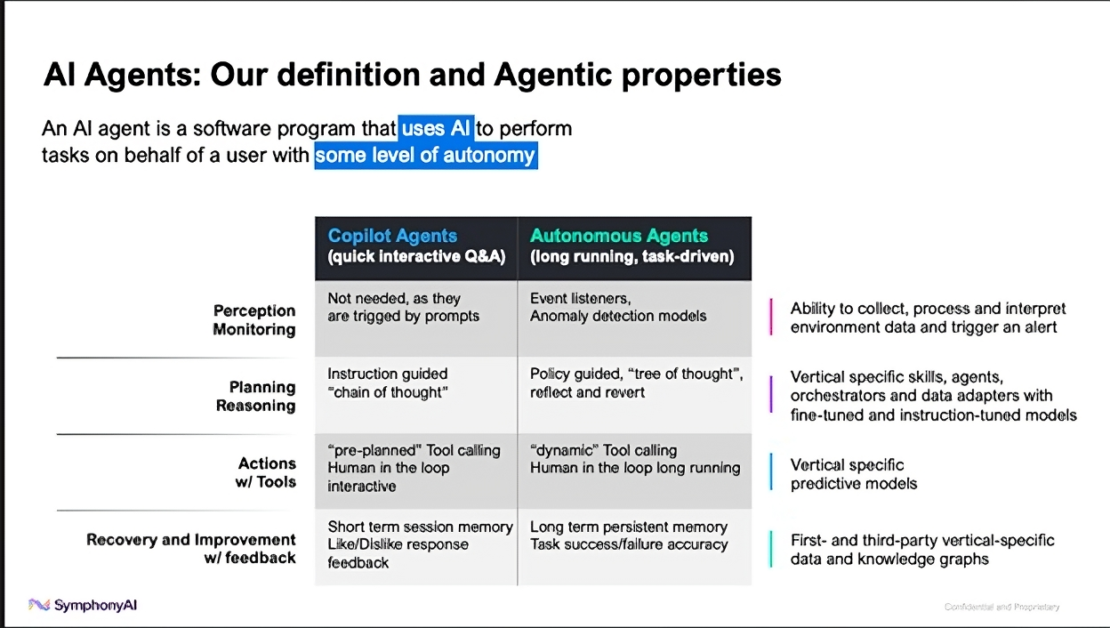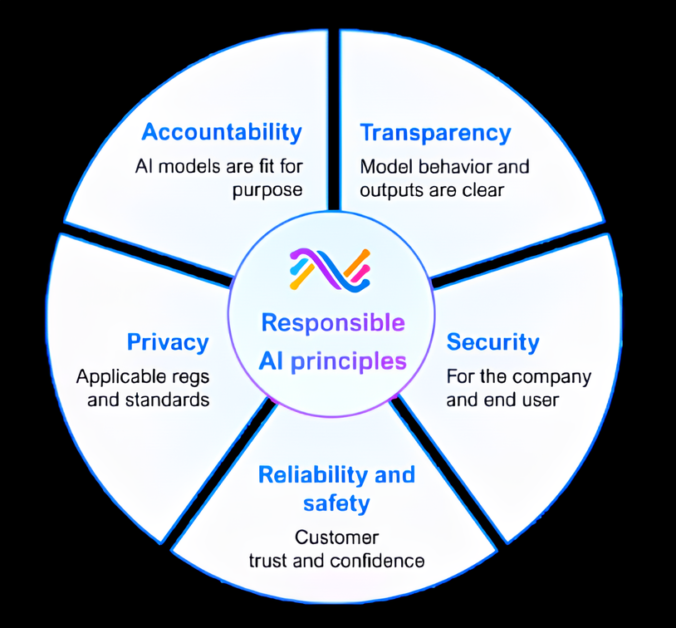
A financial crime investigator who once received large volumes of suspicious activity alerts requiring tedious investigation work manually gathering data across systems in order to weed out false positives and draft Suspicious Activity Reports (SARs) on the others. Today, she receives prioritized alerts with automated research and suggested content that can generate SARs in minutes.
A retail category planner who previously did hours-long analysis of past weeks’ reports to try to uncover insights into which products are underperforming, and why, now uses AI to provide deep-dive insights that surface problem areas and suggest corrective actions, prioritized for maximum business impact. An industrial maintenance engineer uses a copilot that conducts 24/7 asset health monitoring and predicts issues and generates warning at the early stages of mechanical or performance problems, slashing unplanned downtime.
These transformations are happening across enterprises today, signaling a fundamental shift: vertical applications combining predictive, generative, and emerging agentic AI are augmenting and transforming workflow automation, providing targeted, sophisticated capabilities that address far more complex and contextual challenges than earlier solutions.
Gartner's 2024 Hype Cycle for Emerging Technologies highlighted autonomous AI as one of the year's top four emerging technology trends—and with good reason. With non-AI agents, users had to define what they had to automate and how to do it in great detail. But applications combining predictive, generative, and soon agentic AI with specialized vertical knowledge sources and workflows can pull information from disparate sources enterprise-wide, speed and automate repetitive tasks, and make recommendations for high-impact actions. Enterprises using these applications realize faster and more accurate decision-making, rapid problem identification and remediation, and even preventive measures to stop problems from occurring in the first place.
AI agents represent the next wave in enterprise AI. They build upon the foundations of predictive and generative AI but take a significant leap forward in terms of autonomy and adaptability. AI agents are not just tools for analysis or content generation—they are intelligent systems capable of independent decision-making, problem-solving, and continuous learning. This progression marks a shift from AI as a support tool to AI as an active participant in business processes, capable of initiating actions and adapting strategies in real time.

The Evolution from RPA to Autonomous Agents
Traditionally, RPA was used for repetitive, heuristics-based processes and low-complexity tasks with structured data inputs. RPA uses structured inputs and defined logic to automate highly repetitive processes like data entry, transferring files, and filling out forms. The wide availability of affordable, highly effective predictive and generative AI has addressed the next level of more complex business problems requiring specialized domain expertise, enterprise-class security, and the ability to integrate diverse data sources.
At the next level, AI agents go beyond predictive AI algorithms and software with their ability to operate autonomously, adapt to changing environments, and make decisions based on both pre-programmed rules and learned behaviors. While traditional AI tools might excel at specific tasks or data analysis, AI agents can integrate multiple capabilities to navigate complex, dynamic environments and solve multifaceted problems. AI agents can help organizations be more effective, more productive, and improve the customer and employee experience, all while reducing costs.
When built with the right AI models as tools and with vertical data sources and machine learning to support specialized contextual activity, the AI agents become high-productivity workhorses in terms of deciphering the problem, taking the right steps, recovering from mistakes, and improving over time on the given tasks.
Navigating Implementation: Key Aspects for Enterprises to Consider
Implementing predictive, generative, and eventually agentic AI in an enterprise setting can be highly beneficial, but taking the right steps before deployment to ensure success is critical. Here are some of the main considerations for enterprises as they consider and start to roll out AI agents.
- Alignment with Business Goals: For enterprise AI adoption to be successful, it should address specific use cases in specific industries and deliver increased productivity and accuracy. Regularly involve business stakeholders in the AI assessment/selection process to ensure alignment and provide clear ROI. The products should be fitted to processes and workflows that measurably improve outcomes for the defined use cases and vertical domains.Data Quality, Quantity, and Integration: As AI models require large amounts of high-quality data to perform effectively, enterprises must implement robust data collection and processing pipelines to ensure the AI is receiving current, accurate, relevant data. Curating data sources greatly reduces the risk of hallucinations and enables the AI to make the optimal analysis, recommendations, and decisions.Security and Privacy: Handling sensitive data in AI models poses privacy risks and potential security vulnerabilities. Careful consideration about what data is necessary for the AI to do its job, and not providing data that wouldn’t be directly relevant, can help minimize exposure. Applications should also provide role-based and user-based access control with authentication protections built in at the data and API layers and confirm that data doesn’t reach SLMs or LLMs without verification and protection.Infrastructure and Scalability: Running large AI models requires significant computational resources, and scalability can also be an issue. Good design will prevent excess resource consumption – for example, a specialized SLM can be as effective as a more generalized LLM and significantly reduce computational requirements and latencies.Model Interpretation and Explainability: Many AI models, especially deep learning models, are often seen as “black boxes.” Good enterprise AI products proved full transparency, including what sources the models accessed and when, and why each recommendation was made. Having this context is critical to create user confidence and drive adoption.
Potential Drawbacks of AI Agents
As with any new technology, AI agents have a few potential drawbacks. The best AI agent applications rely on human-in-the-loop processes—including all SymphonyAI agentic AI applications and capabilities. This approach allows for human oversight, intervention, and collaboration, ensuring that the agent’s actions align with business goals and ethical considerations. Human-in-the-loop systems can provide real-time feedback, approve critical decisions, or step in when the AI encounters unfamiliar situations, creating a powerful collaboration between artificial and human intelligence.
Responsible AI also delivers a strong user interface, traceability, and the ability to audit the steps of why the agent chose an execution path. We abide by responsible AI principles of accountability, transparency, security, reliability/safety, and privacy.

The Path to Fully Autonomous Agents
It’s hard to predict how realistic the fully autonomous agent scenario is because we haven’t established an industry-wide measure for the level of autonomy. For example, the autonomous driving area has been established regarding Levels 1-5 of Self Driving capability, with zero being no level of automation where the driver performs all driving tasks, to level five being full automation where the vehicle performs all driving tasks.
We are well along in what I see as the third phase of the path to enterprise value with AI – where combined generative and predictive AI applications make sophisticated recommendations and support fluid what-if analysis. At SymphonyAI we see the next phase evolving towards autonomous AI agents, working with predictive and generative AI to speed financial fraud investigations, turbocharge retail category management and demand forecasting, and enable manufacturers to predict and avert machine failures.\
We are currently enhancing the complexity and autonomy of AI agents within our applications, and customer feedback is very positive. Predictive and generative AI have advanced to a level where they can automate workflows that were once deemed too complex for traditional software. Autonomous, or agentic, AI excels in handling these tasks without oversight, leading to transformative productivity gains and allowing human resources to focus on more strategic activities.
For example, a multinational European bank using SymphonyAI Sensa Investigation Hub with AI agents and a copilot has helped financial crime investigators save time on their investigations while simultaneously improving investigation quality. Within weeks, the bank saw average effort savings of approximately 20% in Level 1 and Level 2 investigations. The bank also projects cost savings with SymphonyAI on Microsoft Azure of €3.5m per year, including an 80% decrease in spending with a leading technology provider from €1.5m per year to €300k per year.
With thoughtful, enterprise-class design using responsible AI principles, AI agents deliver transformational productivity, accuracy, and excellence for a growing variety of proven use cases. At SymphonyAI, our mission is to provide enterprises with AI agents that deliver operational excellence. By blending quick responsiveness with long-term strategic thinking, agentic AI is set to revolutionize critical processes across multiple industries.
The post The Path from RPA to Autonomous Agents appeared first on Unite.AI.

